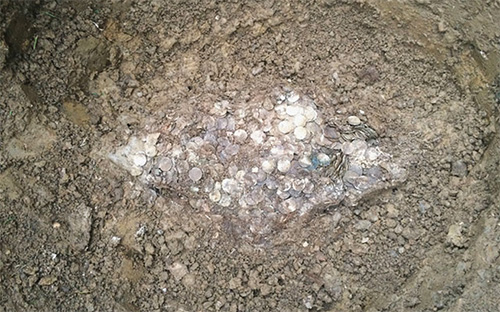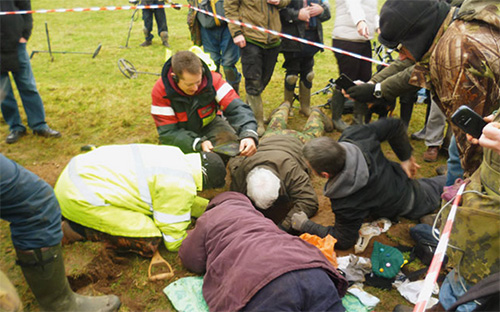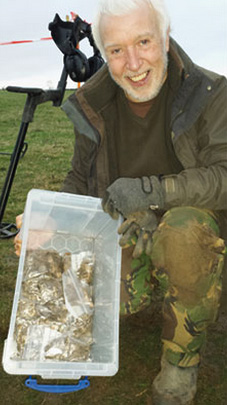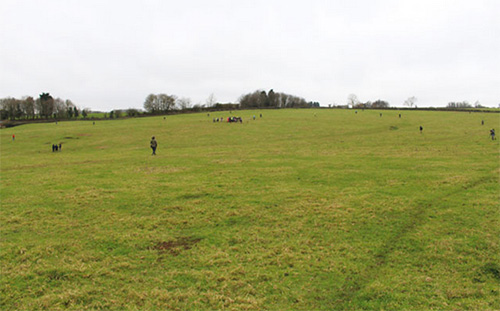COINWORLD | By John Andrew, Coin World London Correspondent | January 23, 2015

5,251 coins discovered during metal detecting rally in countryside
An effort at saving money almost cost one metal detectorist in the United Kingdom a huge fortune.
However, despite the cost of gasoline to get there, his late-hour decision to attend a metal detecting rally paved the way for that hobbyist to find the largest hoard of Anglo-Saxon coins in 175 years.
The value of the hoard of 5,251 coins is estimated at £1.3 million ($1,973,639 U.S.).
On a cold Saturday just five days before Christmas, around 100 treasure seekers gathered with their metal detectors in a large field about 50 miles, as the crow flies, northwest of London.
The rally was organized by Peter Welch of Weekend Wanderers Detecting Club, which he founded in 1990. It operates from Hook in Hampshire and has a reputation of running well-organized treasure digs. It is also the largest metal detecting club in the United Kingdom. It has many members, of all ages and abilities and from diverse walks of life.


One enthusiastic member is 59-year-old Paul Coleman, an old hand who has been seeking the ultimate find for more than four decades. His treasure hunting career has had a great number of false starts, uncovering lots of rubbish, as well as musket balls, buckles and of course coins, mainly Roman. One coin he sold for several hundred pounds.
As he was between projects and putting capital into his new venture, he told me, “I wasn’t going to go to the dig because it would have cost too much in petrol — nearly £45,” adding, “but I managed to persuade a friend and my son to come and share the costs.”
What happened next is the stuff that dreams are made of. Coleman had hesitated to spend the money on petrol as he knew that the chances of finding anything of great value were about the same odds as winning the lottery. But the trio set off on the 100-mile, 100-minute journey to Lenborough, a small hamlet near Buckingham in north Buckinghamshire.
It was a large field. Coleman chose a spot and went into action with his metal detector. When he received a strong signal, potentially indicating a sizable piece of metal was below the surface, he calmly set about digging. Being an experienced treasure seeker, he realized it could be anything and was not optimistic.
“When I had been digging for some time, I moved a few inches of soil with my hand to scoop it out so I could get a little bit deeper. My hand scraped across something and when I looked it was a small piece of lead. When I looked back in the hole, I saw a small circular piece of metal shining,” he said.
He removed what was a hammered silver penny.
Coleman continued: “Then I lifted a large piece of lead and saw row upon row of coins stacked neatly. I did not jump up and down with excitement, but I was grinning from ear to ear.”
Official was on site
Coleman alerted those present that he had made a find. What no one knew at the time was that he had found one of the largest hoards of Anglo-Saxon coins ever discovered in England. As it happened, Ros Tyrell, the finds liaison officer for the area, who is based at the Buckinghamshire County Museum at Aylesbury, was in attendance at the rally. As all archaeological finds in the region have to be reported to her, there was absolutely no delay in advising “the authorities” of this discovery.
Looking at the size of the field, it is absolutely amazing that Coleman searched where he did — there were countless other places for his metal detector to be set into motion. It was also not the first time that the club had visited this particular field.
Everyone dreams of a pot of gold, but in reality treasure seekers spend most of their time digging up junk. “Metal detecting is a bit random,” said Peter Welch, the rally’s organizer, “but most farms have a lot of history, so you have a chance of finding something. I think this was a case of you either move to the right or move to the left and in this case Paul moved the right way.”
It may sound as easy as falling off a log, but this is the first major find Welch has encountered in 25 years of running the club.
The coins were concealed in a folded piece of lead that looked like a giant pasty. It was not deeply buried, being found just 2 feet below the surface. It is the protocol of detectorists to dig a small hole so as to minimize damage to the field. However, Tyrell instructed Coleman and his son to make it wider. It took five hours with people lying on their stomachs to extract the coins from what had been the hoard’s home for around 1,000 years.
Contents of the hoard
Predominantly they are silver pennies of the reigns of Æthelred II, also known as “the Unready” (978 to 1016), and Canute (1016 to 1035).
Canute (also rendered Cnut) was the king of Denmark, England, Norway and parts of Sweden.
Commenting on the coins, Welch said, “They’re like mirrors [and have] no scratching,” adding, “
It looks like only two people have handled these coins — the person who made them and the person who buried them.” It is not only their condition that makes the hoard spectacular, but also the sheer quantity of coins. After the long task of extracting them from their resting place, it took four people 90 minutes to count them on the kitchen table of the farmer who owned the field where they were found.
There were 5,251 whole coins and one half coin — as there was no halfpennies at that time, fractions of a penny were obtained by halving or quartering a whole one. The farmer profusely thanked Coleman for making the discovery, for he will receive half of the proceeds that Coleman receives as the finder.

field in Buckinghamshire, and the December detecting rally wasn’t the first to trace the ground in search of hidden history.
First finds
These are the first Anglo-Saxon coins that Coleman has found. When treasure hunters discover them, the find is normally within the range of five to 20 coins. It is more usual for Roman coins to be found in Buckinghamshire than Anglo-Saxon ones. Indeed, the Buckinghamshire County Museum has 4,000 Roman coins and just 30 Anglo-Saxon specimens.
The largest hoard of Anglo-Saxon coins in recent years was the 490 discovered by treasure hunters at Appledore in Kent during 1997. A dozen more were discovered at the same site a year later. However, the largest find of coins of the era occurred in 1840.
In that year the River Ribble in Lancashire burst its banks at Cuerdale Farm near Ribchester. The flood uncovered a hoard 8,500 pieces of Viking silver weighing around 90 pounds. The hoard contained ingots, broken jewelry and more than 7,000 coins, mostly from mints in Viking-controlled England, but others from as far afield as Central Asia and the Middle East. Our knowledge of the late ninth century Viking coinage is largely based on the study of this hoard. It is thought that the hoard contained as many as 10,000 coins, but there was a “leakage” before the authorities became involved.
There was no such leakage with Coleman’s find, Welch commented. “From the outset it was done properly and I am pleased about that.”

Efficient processing
The handling of a hoard could hardly have been more efficient. It was taken to Tyrell’s home the weekend it was discovered (Dec. 20 and 21) for safekeeping, and to the Buckinghamshire County Museum immediately that Monday morning (Dec. 22), before being delivered to the British Museum in London the next day.
By Jan. 2, 2015, a total of 1,000 of the coins had been cleaned, and by Jan. 8 when Coin World visited the British Museum, Gareth Williams, the curator of Medieval Coins, had already cataloged 800 of the coins.
Early indications are that the coins are generally early issues of the reign of Æthelred the Unready and late issues of Canute. This may mean that two separate stashes were brought together for concealment.
An archaeological report may be submitted to the coroner in February. The coroner’s decision as to whether the coins are treasure will be based on this report.
Assuming that the verdict declares them treasure, the find will be provisionally valued by one or more independent expert valuers. The Treasure Valuation Committee then examines the find against the provisional valuations and recommends a value. Museums are then given the opportunity to buy it at the valuation price, or to return it to the finder.
The ideal home for the hoard would be the Buckinghamshire County Museum at Aylesbury. The value of the hoard bandied about in the press is £1 million (about $1,518,095 U.S.), based on each coin being worth “at least £250.”
The mathematics is not quite right, and the value should be closer to £1.3 million ($1,973,639 U.S.).
It naturally all depends on whether a museum is able to obtain funding for its acquisition. It would take the market a long time to absorb this number of late Anglo-Saxon coins.









